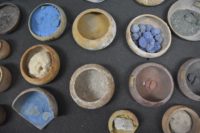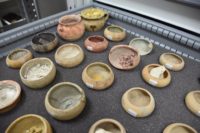 By a series of link-hops that began with archaic Greece and what I hope will soon be a post of its own (it all depends on whether I can get my grubby mits on good pictures), today I wound up in Pompeii. With a prosciutto. A prosciutto-shaped sundial, to be exact. It was portable, as far as we know the earliest portable sundial surviving, which is even more notable a title when you consider that it’s made out of bonze and managed to make it through the eruption of Vesuvius in 79 A.D. intact.
By a series of link-hops that began with archaic Greece and what I hope will soon be a post of its own (it all depends on whether I can get my grubby mits on good pictures), today I wound up in Pompeii. With a prosciutto. A prosciutto-shaped sundial, to be exact. It was portable, as far as we know the earliest portable sundial surviving, which is even more notable a title when you consider that it’s made out of bonze and managed to make it through the eruption of Vesuvius in 79 A.D. intact.
It dates the 1st century A.D. and was first unearthed on June 11th, 1755, in the early Bourbon-era excavations of the site of Herculaneum. The sundial was found in the House of the Papyri, a handsome private villa where a library of charred scrolls were discovered. The scrolls got the lion’s share of the attention, but the silver-gilt bronze portable sundial so recognizably shaped like a prosciutto hanging from the bone while it cures did get some love from the Encyclopédie ou Dictionnaire raisonné des sciences, des arts et des métiers, the ambitious knowledge compendium edited by Denis Diderot and Jean le Rond D’Alembert.
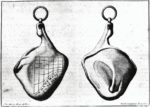 The only problem is the description was not particularly accurate. (Many of the entries in the Encyclopédie left something to be desired in that arena.) The sundial was “in the form of a sleeve,” according to them. In 1762, the first scholarly work to recognize the prosciutto clock for its awesomeness was published. It was the third volume of a much less general encyclopedia — Antiqities of Herculaneum — and the authors corrected the factual errors, barely disguising their contempt that the French encyclopedists couldn’t even recognize a prosciutto when they saw one. Horologists have been discussing the ham with undiminished fervor ever since.
The only problem is the description was not particularly accurate. (Many of the entries in the Encyclopédie left something to be desired in that arena.) The sundial was “in the form of a sleeve,” according to them. In 1762, the first scholarly work to recognize the prosciutto clock for its awesomeness was published. It was the third volume of a much less general encyclopedia — Antiqities of Herculaneum — and the authors corrected the factual errors, barely disguising their contempt that the French encyclopedists couldn’t even recognize a prosciutto when they saw one. Horologists have been discussing the ham with undiminished fervor ever since.
The sundial is now part of the permanent collection of the Museo Archeologico Nazionale di Napoli. It was briefly in New York City this spring as part of the Time and Cosmos exhibition at New York University’s Institute for the Study of the Ancient World. That’s where it found a new fan who introduced new technology to the investigation of the sundial.
Now the “pork clock” ticks once more. Recently re-created through 3-D printing, a high-fidelity model of the sundial is helping researchers address questions about how it was used and the information it conveyed.
The model confirms, for instance, that using the whimsical timepiece required a certain amount of finesse, says Wesleyan University’s Christopher Parslow, a professor of classical studies and Roman archaeology who made the 3-D reconstruction. All the same, “it does represent a knowledge of how the sun works, and it can be used to tell time.” […]
After Parslow was asked about the pork clock, he was inspired to build a 3-D model. He took dozens of photos of the timepiece at its home institution, Italy’s National Archaeological Museum of Naples. A 3-D printer at his university churned out the model—in plastic rather than the original silver-coated bronze—in a matter of hours.
Like the original, Parslow’s model bears a dial, in the form of a slightly distorted grid, on one side. The vertical lines are marked for the months of the year. The horizontal lines indicate the number of hours past sunrise or before sunset.
The original clock is missing its gnomon, the part of a sundial that casts a shadow, but an 18th-century museum curator described it having one in the shape of a pig’s tail, so Parslow re-created that, too.
Parslow then experimented with the sundial outdoors. The clock is hung from a string so that the sun falls on its left side, allowing the attached pig’s tail to cast a shadow across the grid.
The user aligns the clock so that the tip of the tail’s shadow falls on the vertical line for the current month. Finally, the user counts the number of horizontal lines from the top horizontal line to the horizontal line closest to the tip of the shadow. That indicates the number of hours after sunrise or before sunset.
It’s conceivable that he might even be able to tell time to the half-hour, but without the original gnomon he’s having to tinker with curly tail to get the most detailed readings, and it’s not at all clear that the device was meant to be all that precise. A portable sundial was a prestige item more than a practical one and nobody was counting billable hours in 15 minute increments.
The Prosciutto Clock led me to another extraordinary image, this one tweeted by the Pompeii Sites account. This is the collection of pigment cups left behind by painters fleeing the eruption of Vesuvius in 79 A.D., most of them with the pigments or raw materials thereof still in brilliant color.
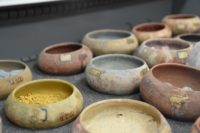
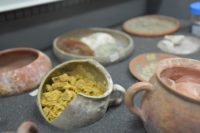
Following the trail of Internet breadcrumbs, I found Dr. Sophie Hay’s reply to the Pompeii Sites’ tweet of the rainbow of pigment jars. She was on the team that excavated those pots, which is insanely cool. The containers and their dazzling contents came from a painter’s workshop near the House of the Chaste Lovers where an unfinished fresco, a red frame around a white square, was found. On the same insula — a large multi-use block of more than 1500 square meters with homes, retail like a bakery and wine shop, and artisan workshops — a room was found in classic Pompeiian “frozen in time” mode. Apparently before the eruption a crew was working on the hydraulic network while painters had started redecorating the frescoes in the main hall. They had just finished the preparatory drawings when something suddenly came up, almost certainly Vesuvius’ roasting hot insides. The artists must have been in a rush because they left all of the pigments, which were certainly expensive not to mention necessary to their livelihood, behind. This great find gave the structure its modern name: the House of the Painters at Work.
The House of the Chaste Lovers, named after a completed fresco depicting a modest kiss at a dinner, belonged to wealthy baker (the bakery storefront next door was apparently his) and is an exceptional survival in a lot of ways. It’s one of very few two-story buildings in Pompeii with the second story still attached to it. The bakery’s oven and millstones are intact, as are two of its stables, complete with skeletal remains of seven animals. It has been excavated off and on since 1982, and the public have only been allowed in on very rare occasions. The week of Valentine’s Day this year was one those occasions, a tribute to the famous fresco with its sweet kiss on the reclining couch.
The pigment bowls were no longer in situ by then. In 2014, Professor Massimo Osanna, Director General of the Pompeii archaeological site, deposited the entire collection of pigments cups in the Laboratory of Applied Research which specializes in the study and conservation of Pompeii’s unique combination of archaeological materials, including organic, mineral and lithic remains. It has a state-of-the-art climate control system to keep the most delicate remains from degrading, and is therefore best equipped to preserve the vivid color of the ancient pigments.
Graphic artist Gareth Blayney made a series of drawings of how the shopfronts might have looked before the Vesuvian apocalypse for Dr. Hay and they are all beautiful, but the one of the paint shop truly does the riot of pigment jars justice.
